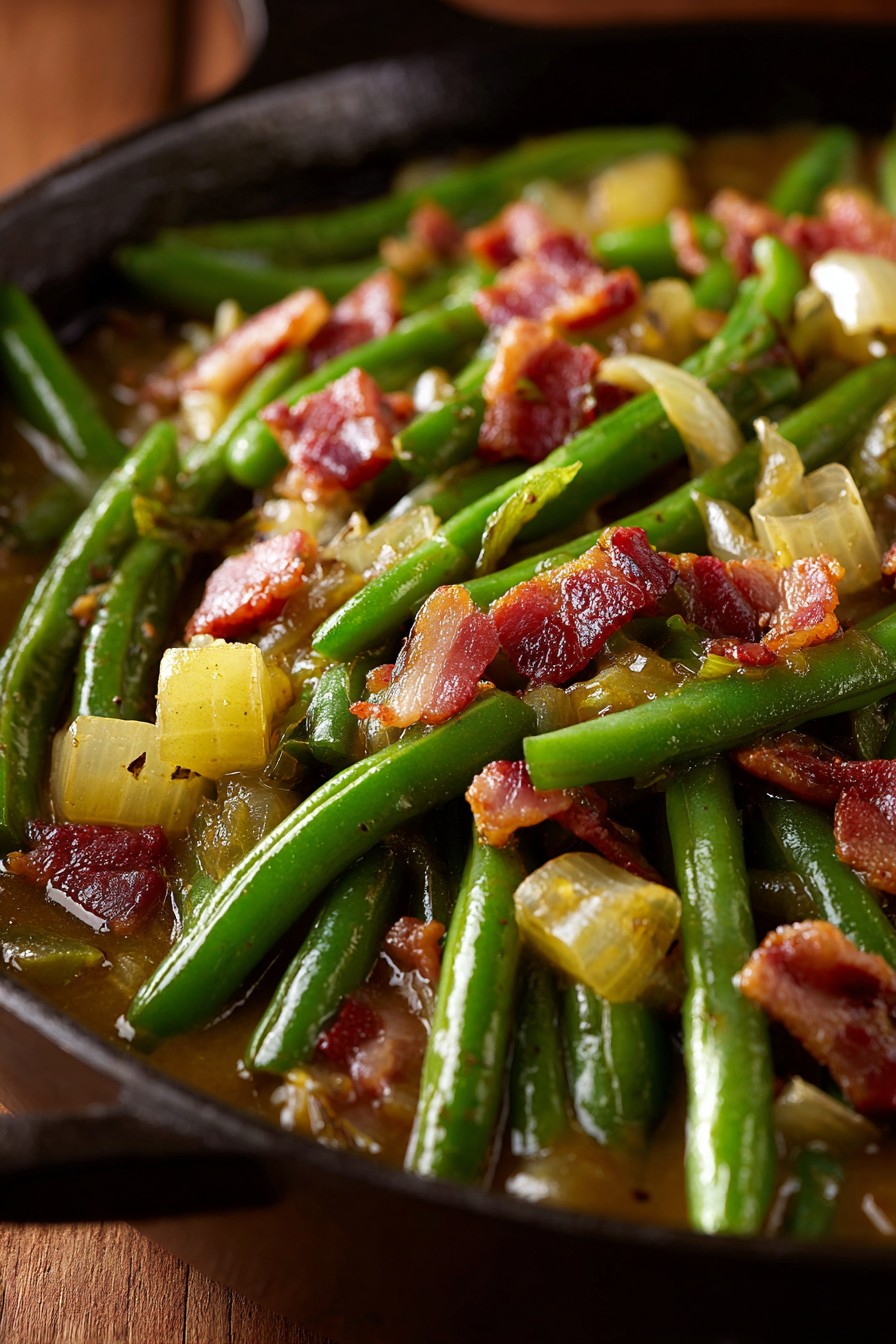Cradled in the heart of Southern kitchens yet whispering tales of Mediterranean sun and Asian markets, country green beans transform humble pods into a symphony of slow-cooked comfort. Centuries of Appalachian tradition meet global soul in this dish where beans surrender their crispness to become velvet vessels for smoky pork and aromatic spices. Come journey through time and taste as we explore how this American classic carries echoes of French cassoulet and Chinese braised vegetables in every tender bite.
Why This Recipe Works
- The slow simmering technique, reminiscent of French confit, allows green beans to absorb the rich, smoky essence of pork while transforming their texture from crisp to luxuriously tender without becoming mushy
- Building flavor layers through rendered pork fat creates a foundation that echoes the umami depth found in Chinese braised dishes, where animal fats carry spice and seasoning deep into vegetables
- Balancing the saltiness of smoked pork with the natural sweetness of onions mirrors the sweet-savory harmony celebrated in Mediterranean cooking, creating complexity that satisfies across cultural palate preferences
- Using chicken broth as the braising liquid infuses the beans with herbal notes that recall Italian contorni while maintaining the hearty character expected of Southern vegetable preparations
- The final splash of vinegar provides the bright acidity found in Korean banchan, cutting through the richness and awakening the palate to the layered flavors developed during cooking
Ingredients
- 2 pounds fresh green beans, washed and trimmed
- 6 ounces thick-cut bacon, chopped into 1/2-inch pieces
- 1 large yellow onion, finely diced
- 4 cloves garlic, minced
- 4 cups chicken broth
- 2 tablespoons apple cider vinegar
- 1 teaspoon black pepper
- 1/2 teaspoon red pepper flakes
- 1 teaspoon granulated sugar
Equipment Needed
- Large Dutch oven or heavy-bottomed pot
- Wooden spoon or spatula
- Sharp chef’s knife
- Cutting board
- Measuring cups and spoons
- Colander
Instructions

Prepare the Foundation with Smoky Pork
Begin by placing your Dutch oven over medium heat and adding the chopped bacon, allowing it to render slowly for 8-10 minutes until the fat melts away and the pieces become crispy and golden brown. This process mirrors the Italian guanciale preparation where pork fat becomes the cooking medium, carrying smoky depth into every component. As the bacon sizzles, resist the temptation to stir too frequently—this allows proper browning and develops the Maillard reaction that creates complex flavor compounds. You’ll know the bacon is perfectly rendered when the pieces float in their own liquid gold and achieve a mahogany hue with crisp edges. Using a slotted spoon, transfer the bacon to a paper towel-lined plate, leaving about 3 tablespoons of the precious rendered fat in the pot. This reserved fat will become the flavor vehicle that carries aromatics and spices, much like schmaltz in Jewish cooking or lard in traditional Mexican recipes.
Sauté Aromatics to Build Flavor Layers
Add the finely diced yellow onion to the hot bacon fat, stirring to coat every piece in the smoky liquid. Cook for 6-8 minutes until the onions become translucent and begin to caramelize at the edges, developing the sweet notes that balance the pork’s saltiness. This technique mirrors the French mirepoix foundation where onions provide sweetness to counter rich meats. When the onions have softened and developed golden spots, add the minced garlic and cook for exactly 60 seconds until fragrant but not browned—the short cooking time preserves garlic’s sharp character that will mellow during braising. Tip: For deeper flavor, you could substitute half the onion with shallots, which would add the subtle complexity found in Southeast Asian cooking where shallots provide aromatic depth to slow-cooked dishes.
Create the Braising Liquid Base
Pour the chicken broth into the pot, using your wooden spoon to scrape any browned bits from the bottom—these fond particles hold concentrated flavor that will infuse the entire dish. Add the black pepper, red pepper flakes, and granulated sugar, then bring the liquid to a vigorous boil over high heat. The sugar may seem unusual, but it serves the same purpose as the palm sugar in Thai curries—balancing saltiness while promoting caramelization during cooking. Allow the broth to boil uncovered for 3 minutes to slightly reduce and concentrate the flavors, creating a more potent cooking medium. The boiling process also helps emulsify the bacon fat into the broth, creating a richer base than simply mixing cold ingredients.
Braise Green Beans to Tender Perfection
Carefully add the washed and trimmed green beans to the boiling broth—they should be mostly submerged in the liquid. Reduce the heat to maintain a gentle simmer, cover the pot with a tight-fitting lid, and cook for 45-55 minutes. This extended cooking time transforms the beans’ texture from crisp to meltingly tender, similar to Greek fasolakia where green beans become almost creamy through slow cooking. Check at 45 minutes by tasting a bean—it should offer no resistance when bitten but still maintain structural integrity. The beans will have absorbed the smoky broth and turned olive green, with their natural sweetness amplified by the slow heat penetration.
Finish with Bright Acidity and Crisp Texture
Once the green beans reach your desired tenderness, remove the lid and increase the heat to medium-high to reduce the remaining liquid by half, which should take about 5-7 minutes. This reduction concentrates the flavors and creates a light sauce that clings to the beans. Stir in the apple cider vinegar—this bright acidity cuts through the richness, much like the lemon juice finish in Turkish vegetable dishes. Finally, return the crispy bacon to the pot, stirring to distribute throughout. The bacon will maintain some crunch despite the moisture, providing textural contrast. Tip: For restaurant-style presentation, reserve a tablespoon of crispy bacon to sprinkle over the top just before serving.
Tips and Tricks
For those seeking to elevate this humble dish to new culinary heights, consider these advanced techniques drawn from global cooking traditions. When selecting green beans, seek out the thinner haricots verts variety if available—their delicate structure and sweeter flavor profile absorb braising liquids more efficiently, resulting in a more refined texture reminiscent of French fine dining. For maximum flavor extraction from your smoked pork, try using pancetta instead of bacon—its more subtle smokiness and richer pork flavor create a sophisticated base that won’t overpower the other ingredients. If you have access to specialty markets, consider sourcing guanciale for an authentic Italian influence or Chinese lap cheong sausage for an Asian fusion twist that introduces sweet and spicy notes.
The cooking vessel itself can dramatically impact your results—a well-seasoned cast iron Dutch oven provides superior heat distribution that mimics the earthenware pots used in Mediterranean and North African tagine cooking, where slow, even heat transformation is crucial. For those preferring brighter colored beans, add a pinch of baking soda to the braising liquid—this alkaline environment helps preserve chlorophyll, though it may slightly alter texture. Drawing from Japanese cooking wisdom, consider adding a 2-inch piece of kombu seaweed to the broth during braising—it contributes subtle umami depth that enhances the savory character without making the dish taste fishy.
Timing is everything with braised vegetables—if preparing ahead, undercook the beans by 10 minutes and let them finish heating through when reheating to avoid mushiness. The broth reduction phase offers customization opportunities—stir in a tablespoon of tomato paste for Italian-inspired richness or a teaspoon of miso for Japanese umami complexity. For textural variety, consider adding toasted breadcrumbs or crushed almonds as a finishing garnish, providing the crunch contrast found in Middle Eastern vegetable dishes. Finally, remember that like many braised dishes, country green beans often taste better the next day as flavors continue to meld and develop depth overnight.
Recipe Variations
- Mediterranean Fusion: Replace bacon with 4 ounces of diced pancetta and add 1/2 cup of sun-dried tomatoes and 1/4 cup of sliced Kalamata olives during the last 15 minutes of cooking. Finish with 2 tablespoons of fresh oregano and a drizzle of extra virgin olive oil to transport this Southern classic to the Italian countryside where bright acidity and herbal notes dominate the flavor profile.
- Asian-Inspired Twist: Substitute the bacon with 4 ounces of Chinese lap cheong sausage and add 1 tablespoon of grated fresh ginger with the garlic. Replace 1 cup of chicken broth with coconut milk and finish with 1 tablespoon of fish sauce and 1 teaspoon of sesame oil for a Southeast Asian flavor journey that balances sweet, salty, and umami elements.
- Vegetarian Adaptation: Omit the bacon entirely and begin by sautéing the onions in 3 tablespoons of olive oil. Add 1 teaspoon of smoked paprika to replicate the smoky depth, and use vegetable broth instead of chicken. For extra richness, stir in 2 tablespoons of tahini during the final reduction phase, creating a creamy texture inspired by Middle Eastern vegetable preparations.
- Spicy Cajun Version: Increase red pepper flakes to 1 tablespoon and add 1 teaspoon of Cajun seasoning with the broth. Include 1 diced bell pepper and 2 stalks of celery with the onions for the Holy Trinity base, and finish with hot sauce and chopped fresh parsley to capture the vibrant spirit of Louisiana cooking.
- Creamy Southern Style: During the final reduction, stir in 1/2 cup of heavy cream and 1/4 cup of grated Parmesan cheese, allowing the sauce to thicken into a luxurious coating. This variation draws inspiration from French gratins while maintaining the comfort food essence that defines Southern vegetable dishes.
Frequently Asked Questions
Can I use frozen green beans instead of fresh?
While fresh beans provide superior texture and flavor absorption, frozen green beans can work in a pinch with adjustments to cooking time. Since frozen beans are typically blanched before freezing, they require less braising time—start checking for tenderness at 25 minutes rather than 45. The cellular structure of frozen vegetables is more delicate due to ice crystal formation, so they may become softer faster. For best results, thaw frozen beans completely and pat them dry before adding to the pot to prevent excess water from diluting your flavorful broth. The final texture will be slightly different but still delicious, similar to how frozen vegetables perform in Indian sabzi preparations where they still absorb spices effectively.
What’s the purpose of cooking green beans for so long?
The extended cooking time serves multiple purposes that transform this from a simple side dish to a deeply flavorful experience. Unlike quick-steamed beans that maintain crispness, slow braising allows the beans to fully absorb the smoky pork essence and seasoned broth, much like Italian fagiolini in umido or Greek braised green beans. The prolonged heat breaks down the beans’ fibrous structure, creating a meltingly tender texture that contrasts beautifully with the crispy bacon garnish. This method also develops deeper, more complex flavors through Maillard reactions and ingredient integration that can’t be achieved with quick cooking techniques. The resulting dish becomes a vegetable preparation where the beans act as flavor carriers rather than standalone elements.
Can I make this dish vegetarian while maintaining depth of flavor?
Absolutely—the vegetarian adaptation can achieve remarkable complexity through strategic ingredient substitutions. Begin by building flavor foundation with sautéed mushrooms or eggplant, which provide umami depth when browned properly. Incorporate smoked salts or liquid smoke in minimal quantities to replicate the smoky notes, and consider adding a piece of kombu seaweed to the broth for natural glutamate content. Nutritional yeast or miso paste stirred in at the end can contribute savory characteristics, while toasted walnuts or almonds added as garnish provide the textural contrast and richness typically offered by pork. The key is layering multiple flavor sources rather than relying on a single substitute, much like how Buddhist vegetarian cooking in Asia creates meatless dishes with surprising depth.
How should I store and reheat leftovers?
Country green beans actually improve in flavor when stored overnight as the ingredients continue to meld. Transfer cooled beans to an airtight container and refrigerate for up to 4 days. For reheating, gentle methods work best to preserve texture—either warm slowly in a covered saucepan over low heat with a splash of water or broth to prevent drying, or microwave in 30-second intervals stirring between each. Avoid boiling during reheating as this can further break down the beans’ structure. If the beans seem too soft upon reheating, you can refresh them with a splash of vinegar or lemon juice to brighten the flavors. Like many braised dishes across cultures, the leftovers often taste even better than the freshly made version.
What main dishes pair well with country green beans?
The rich, savory character of these beans makes them incredibly versatile across culinary traditions. They complement Southern classics like fried chicken or pork chops beautifully, standing up to robust flavors while providing vegetable balance. For Italian-inspired meals, serve alongside roasted chicken or meatballs where the beans’ slow-cooked nature echoes other traditional preparations. The dish also pairs wonderfully with grilled fish, where the smoky elements create harmony with the char from the grill. When planning vegetarian menus, these beans can anchor the plate alongside cornbread or biscuits, creating a satisfying meatless option. Consider the beans’ intensity when pairing—lighter proteins allow the beans to shine while heavier mains create a comforting, hearty combination.
Summary
This country green beans recipe transforms simple ingredients through slow braising into a dish that carries echoes of global culinary traditions while remaining quintessentially Southern. The method creates tender beans infused with smoky pork essence, balanced by sweet onions and bright vinegar—a harmony of textures and flavors that improves with time. Whether enjoyed as a comforting side or vegetarian main, these beans tell a story of cultural exchange through every flavorful bite.



